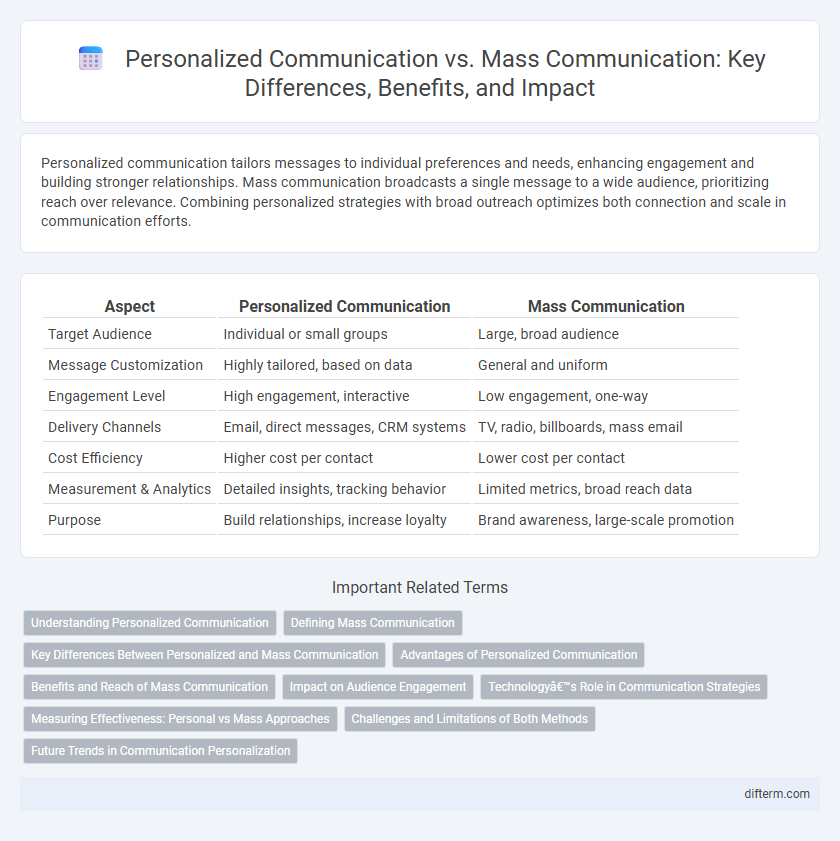Personalized communication tailors messages to individual preferences and needs, enhancing engagement and building stronger relationships. Mass communication broadcasts a single message to a wide audience, prioritizing reach over relevance. Combining personalized strategies with broad outreach optimizes both connection and scale in communication efforts.
Table of Comparison
| Aspect | Personalized Communication | Mass Communication |
|---|---|---|
| Target Audience | Individual or small groups | Large, broad audience |
| Message Customization | Highly tailored, based on data | General and uniform |
| Engagement Level | High engagement, interactive | Low engagement, one-way |
| Delivery Channels | Email, direct messages, CRM systems | TV, radio, billboards, mass email |
| Cost Efficiency | Higher cost per contact | Lower cost per contact |
| Measurement & Analytics | Detailed insights, tracking behavior | Limited metrics, broad reach data |
| Purpose | Build relationships, increase loyalty | Brand awareness, large-scale promotion |
Understanding Personalized Communication
Personalized communication tailors messages to individual preferences, behaviors, and needs, enhancing engagement and response rates. It leverages data analytics and customer profiles to create relevant content that resonates on a personal level. This approach contrasts with mass communication, which broadcasts uniform messages to broad audiences without customization, often resulting in lower impact and engagement.
Defining Mass Communication
Mass communication involves disseminating information to a large, diverse audience through mediums such as television, radio, newspapers, and digital platforms. It emphasizes standardized messages designed to reach broad demographics simultaneously, often lacking individual customization. This approach prioritizes efficiency and wide reach over personalized interaction or tailored content.
Key Differences Between Personalized and Mass Communication
Personalized communication targets individual recipients by tailoring messages based on their preferences, behaviors, and demographics, resulting in higher engagement and conversion rates. Mass communication, on the other hand, disseminates a single, uniform message to a broad audience, prioritizing reach over customization and often yielding lower response rates. The key differences lie in the customization level, audience segmentation, and the effectiveness of message resonance with the target group.
Advantages of Personalized Communication
Personalized communication enhances customer engagement by tailoring messages to individual preferences, increasing relevance and response rates. It enables businesses to build stronger relationships through targeted content, fostering loyalty and trust. Data-driven personalization reduces waste in marketing efforts, ensuring resources are efficiently allocated to high-potential leads.
Benefits and Reach of Mass Communication
Mass communication offers unparalleled reach, efficiently delivering messages to millions across diverse demographics via television, radio, and digital platforms. Its broad coverage enables brands and organizations to increase awareness rapidly and establish a unified message at scale. Cost-effectiveness and consistency in messaging empower advertisers to maximize impact while maintaining budget control.
Impact on Audience Engagement
Personalized communication significantly enhances audience engagement by tailoring messages to individual preferences and behaviors, resulting in higher response rates and stronger emotional connections. In contrast, mass communication, while efficient for broad reach, often struggles to capture attention due to its generic nature, leading to lower interaction levels. Data-driven personalization leverages customer insights to deliver relevant content, boosting loyalty and conversion rates more effectively than one-size-fits-all approaches.
Technology’s Role in Communication Strategies
Technology enhances personalized communication by leveraging data analytics and AI algorithms to deliver targeted messages tailored to individual preferences, improving engagement and customer satisfaction. Mass communication benefits from digital platforms and automation tools that efficiently broadcast information to large audiences while maintaining consistency and real-time interaction capabilities. Integrating CRM systems and omnichannel strategies enables organizations to balance personalized and mass communication, optimizing outreach effectiveness and resource allocation.
Measuring Effectiveness: Personal vs Mass Approaches
Measuring the effectiveness of personalized communication involves tracking engagement metrics such as click-through rates, conversion rates, and customer satisfaction scores, which are typically higher due to targeted messaging. Mass communication effectiveness is often evaluated using broader metrics like reach, frequency, and overall brand awareness, with lower individual engagement but higher audience breadth. Advanced analytics and A/B testing help optimize both approaches by providing detailed insights into audience behavior and response patterns.
Challenges and Limitations of Both Methods
Personalized communication faces challenges such as scalability issues and the need for extensive data collection, which raises privacy concerns. Mass communication struggles with the limitation of delivering generic messages that often fail to engage diverse audience segments effectively. Both methods encounter difficulties in balancing message relevance with resource allocation and audience reach.
Future Trends in Communication Personalization
Future trends in communication personalization emphasize leveraging artificial intelligence and big data analytics to tailor messages based on individual preferences, behaviors, and real-time feedback. Advanced algorithms enable hyper-targeted content delivery across multiple platforms, enhancing engagement and conversion rates. Integration of immersive technologies like augmented reality and virtual assistants will further elevate personalized experiences by creating interactive and context-aware communication.
personalized communication vs mass communication Infographic

 difterm.com
difterm.com